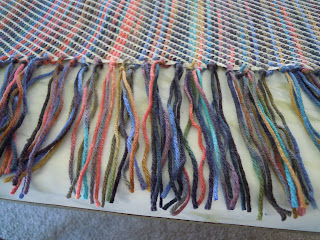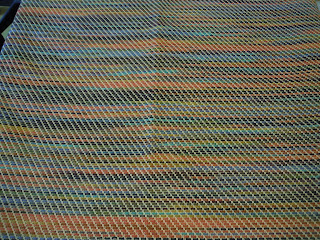I go to online sales places every so often and look for Bucilla kits that I don't already have so I can check out the patterns. The yarn goes into my stash and I make any pattern I darn well want with the mesh.
The post that is the most viewed is the one where I completely botched the plaid pattern. Well, I finally found out how the manufacturer planned for it to be woven correctly.
First you weave the length of the mesh as usual. You'll include all the stripes in the colors you imagine - all as usual.
The post that is the most viewed is the one where I completely botched the plaid pattern. Well, I finally found out how the manufacturer planned for it to be woven correctly.
First you weave the length of the mesh as usual. You'll include all the stripes in the colors you imagine - all as usual.
Here is part of the photo from the kit I bought. Honestly, you can get as fancy as you wish. It won't be any harder or easier one way or the other.
Once you have completed the length of the fabric, measure across the afghan. You are going to cut yarn to only 3-4 inches longer than the width. Only cut yarn in the colors you want the stripes to be. You don't have to cut anything in the main background color.
You will weave across the fabric under and over the lengthwise yarn. Do not weave into the mesh at all.
To finish the edges, the instructions say that you will weave in the ends on the back side in such a way that they don't show through to the front.
Wash this afghan carefully and don't put it in the dryer. Lay it flat to dry.
I hope this helps. I plan to work on a shawl with this kind of pattern soon. I'll post pictures when I do.
Thanks for visiting with me,
Kathi



























